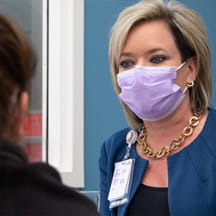Pediatric caregivers have made strides in quality over the past two decades. But in the face of an array of changes—both in children’s medicine and the world around us—there’s a common desire to accelerate the curve and achieve bigger gains in improvement of outcomes for patients and families and within communities.
Children’s hospitals and health systems, pediatric health care organizations and pediatric practitioners are working toward this goal. Here’s a look at leaders’ insights into the next generation of quality—and how we take what we’ve learned to move us there.
A solid foundation
As we look to the future, it is essential we appreciate how far things have come. “We are well prepared for this next iteration,” says Katy Welkie, RN, B.S.N., MBA, chief executive officer, Intermountain Primary Children’s Hospital in Salt Lake City, Utah. “We have learned a lot over the past 20- plus years.” That includes advancements in five areas:
Safety as a domain of quality. Widespread investments in improving safety have led to strides in this quality domain. “It’s foundational to the care we provide,” Welkie says.
Professional expertise. With an emphasis on education, training and home-grown approaches in quality improvement science, thousands of pediatric health care providers have expanded the health care system’s potential for change.
Data and analytics. Growth of institutional and comparative data and analytical capabilities—and the willingness to share those findings— is essential.
Leadership. Many children’s hospitals have adopted organizational models that support broad improvement through increased capacity and infrastructure.
Collaboration. Children’s hospitals have uncovered better methods for sharing information through collaborative efforts. Reimagining quality, and taking a step forward, would not be possible without these contributions and building upon the foundation, Welkie says. “Isaac Newton said, ‘If I have seen further, it is by standing on the shoulders of giants,’ and that is absolutely true in the work of quality.”
New objectives, new ideas
So, what is the path forward? While it’s important to build on the foundation that is already established, it’s also critical to blaze a new trail. “If we keep doing what we’re doing, we’re not going to get a different outcome—we’re not going to go broader, we’re not going to go faster, and we’re not going to make a quantum leap,” says Fiona Levy, M.D., MBA, executive director, Sala Institute for Child and Family Centered Care, Hassenfeld Children’s Hospital at NYU Langone.
“To achieve the outcome of significant change, we have to change the way we work.” Levy says the next generation of quality will not be about one institution, project, collaborative or network. It’s an approach and will embody a movement of ideation, action and learning.
It will be important to engage clinicians across the continuum as well as partner organizations, including the American Academy of Pediatrics, the American Board of Pediatrics, industry partners, advocacy groups, and most importantly patients and families. “We have to go big and broad to bring in some ideas we haven’t had before,” Levy says.
Shifting the mind-set
Ulfat Shaikh recalls early in her career working in a busy outpatient primary care clinic when she noticed how much time patients spent waiting for services at the clinic—waiting to be seen, to receive test results, to hear their provider’s diagnosis. One day, she decided to follow a handful of patients throughout their entire journey in the office and drew a “spaghetti diagram” to show their long, winding paths.
“That started my interest in quality improvement and the science behind these concepts,” says Shaikh, M.D. M.P.H., M.S., medical director for health care quality, University of California Davis Health. She says adopting the “improver’s mind-set” is key to improvement. Everyone is busy tending to the day-to-day rigors of their job, but it’s essential to always be looking for ways to enhance quality.
“We can look at band-aids and workarounds to improvement, and carry on being frustrated,” Shaikh says. “Or we can take the helm of being the agent of change to make sure care is improved for our patients and easier to deliver for ourselves and our peers.”
Next-generation priorities
Building on past successes, rethinking and redesigning approaches and work efforts and embarking on the future with a renewed mind-set can help develop a framework of quality priorities.
“If we’re going to make a leap, we have to be strategic and focused on how we go about broadening the continuum and working with the other sectors to make improvements,” says Angelo P. Giardino, M.D., Ph.D., chair of the University of Utah School of Medicine’s Department of Pediatrics and chief medical officer at Intermountain Primary Children’s Hospital. Giardino offers four key themes of next-generation quality priorities:
1. Quality beyond safety
The domain of safety—one of six quality domains (safe, effective, patient-centered, timely, efficient and equitable) outlined by the Institute of Medicine—is foundational and generally assumed as a given by patient families. While its critical no ground is lost in efforts here, the drive to zero harm can siphon focus away from other domains.
Future quality efforts will rely upon a more balanced portfolio to drive improvement. “We have an obligation to work with families and children to identify the outcomes that matter to them, measure how we’re doing on those outcomes and share that information with families,” says Ron Keren, M.D., M.P.H., chief medical officer, Children’s Hospital of Philadelphia. “This will prioritize our improvement work, which will move the needle on those outcomes.”
2. Partnerships
“The COVID-19 pandemic has exposed gaps in our public health infrastructure,” Keren says. “These gaps have been felt most prominently in communities of color and economic deprivation.” Among them: lack of surveillance systems, personnel for contact tracing, inadequate data collection and sharing, fragmented and slow public health guidance and an initially challenged vaccine distribution system. Compounding those factors, Keren says, was a lack of pre-pandemic public health efforts in communities, contributing to higher rates of obesity, hypertension and cardiac disease—leading to increased risk of death or serious illness due to COVID-19. Forging or solidifying these partnerships can improve outcomes for children while providing hospitals with important learning opportunities.
“Our communities are filled with experts who know patients and families in ways that we do not,” says Lee Beers, M.D., president, American Academy of Pediatrics and medical director of community health and advocacy, Children’s National Hospital in Washington D.C. “Their expertise is invaluable.”
3. Behavioral health
The country was experiencing a steady rise in the incidence of pediatric behavioral health cases before COVID-19, and the pandemic exacerbated the situation. The stresses of the pandemic and social isolation amid widespread school closures hit kids hard—Children’s Hospital Association’s Pediatric Health Information System reports in the first half of 2021, cases of self-injury and suicide in children ages 5-17 occurred at a 45% higher rate than during the same period in 2019.
The current crisis has exposed the limitations of the already strained behavioral health care system in capacity, workforce and programming from the community setting through acute care for children and teens. “We need to increase the resources and attention we direct to improving behavioral health outcomes and ascribe to them the same importance and economic value we ascribe to physical health outcomes,” Keren says.
4. Health care equity
Of the six quality domains, improvement perhaps lags most significantly in the equity of care. A review published by the American Academy of Pediatrics in 2007 of nearly 60 years of studies on the issue concluded “… racial/ethnic disparities in children’s health and health care are extensive, pervasive and persistent, and occur across the spectrum of health and health care.”
The persistence of inequities is due in part to the relative lack of focus in addressing them. A survey among members of CHA’s Quality and Safety Leaders Forum in 2019 found equity ranked last among the six domains.
“Not surprising to anyone, sadly, the equity domain has played second fiddle to the remaining five domains for decades,” says Paul Sharek, M.D., M.P.H., vice president, chief quality and safety officer, associate chief medical officer, Seattle Children’s. “To achieve quantum improvements in child health outcomes, a focus on equity must be prioritized.”
The first challenge may be to ensure everyone is on the same page regarding the extent to which disparities exist. Marcy Doderer, 2021 chair of CHA’s Board of Trustees, says in her conversations with colleagues around the country, she sees a disconnect in how equity in pediatric health care is quantified.
“We have variations in how we’re measuring equity, how comfortable we are with measuring it and—almost more importantly—how comfortable we are speaking to those metrics and the outcomes,” says Doderer, FACHE, president and chief executive officer, Arkansas Children’s.
Beers adds the key to addressing inequities in care for your community is to look inward at your institution’s systems and spark change from within. Beers says. “It is an area where we’ve fallen short, and we must work to actively address.”



